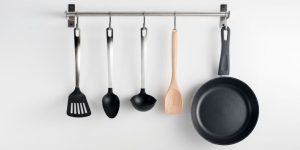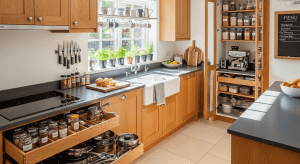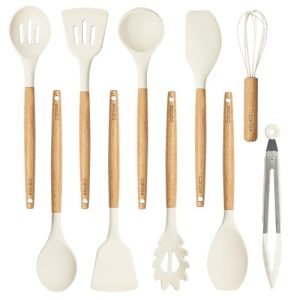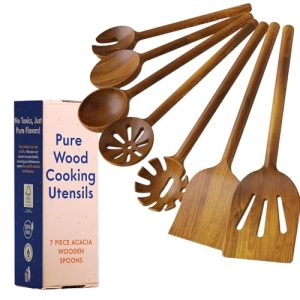If you want to make the perfect eggs every time, cooking them in a cast iron skillet is a game-changer. Imagine crispy edges, a tender center, and rich flavor that only cast iron can deliver.
Whether you like your eggs scrambled, fried, or sunny-side up, mastering this simple technique will elevate your breakfast to a whole new level. Keep reading, and you’ll discover easy tips that will make your eggs in a cast iron skillet taste better than ever before.
Your mornings are about to get a lot more delicious.
Choosing The Right Cast Iron Skillet
Choosing the right cast iron skillet is key to cooking perfect eggs. The right skillet offers even heat and easy cleanup. It also fits your cooking style and kitchen needs. Picking the wrong size or shape can make cooking eggs tricky. Proper seasoning keeps the skillet non-stick and ready for use.
Size And Shape Considerations
Skillet size affects how many eggs you can cook at once. A 10-inch skillet is ideal for 2 to 4 eggs. Smaller skillets work well for single servings. Larger skillets are good for family meals or multiple eggs.
Shape matters too. A skillet with low, sloped sides helps flip eggs easily. Deeper skillets can hold more ingredients for egg dishes. Choose a skillet that fits your stove and storage space.
Seasoning And Maintenance Tips
Seasoning makes the skillet surface smooth and non-stick. Use oil to coat the skillet and bake it at high heat. Repeat this process for a strong seasoning layer.
After cooking, clean the skillet with warm water and a brush. Avoid soap to keep the seasoning intact. Dry it immediately to stop rust. Apply a thin oil layer before storing to protect the surface.
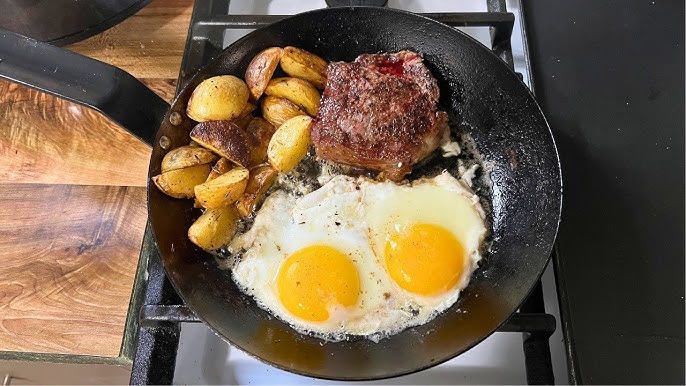
Credit: www.youtube.com
Preparing The Skillet For Cooking
Preparing your cast iron skillet correctly sets the foundation for perfectly cooked eggs every time. The right technique ensures even heat distribution and prevents sticking, so your eggs come out just the way you like them. Let’s look at how to get your skillet ready before you crack those eggs.
Proper Heating Techniques
Start by placing your cast iron skillet on low to medium heat. Avoid turning the heat too high too quickly—it can cause hot spots and uneven cooking. Give the skillet a few minutes to warm up gradually; you want it evenly heated all over.
Test the heat by flicking a few drops of water onto the surface. If the drops dance and evaporate quickly, your skillet is ready. This simple trick helps you avoid under or overheating, which can ruin the texture of your eggs.
Using The Right Cooking Fats
Choosing the right fat can make a huge difference in flavor and texture. Butter adds richness and a slight nutty taste, but it can burn if the heat is too high. For a more stable option, try using oils with a high smoke point like avocado or grapeseed oil.
You can also mix fats—start with oil to protect the pan, then add a bit of butter for flavor. This combo gives you the best of both worlds without the risk of burning. How do you usually prepare your skillet—have you noticed how different fats change the taste and cooking experience?
Perfecting The Crispy Egg
Perfecting the crispy egg in a cast iron skillet can transform your breakfast routine. Achieving that delicate crunch on the edges while keeping the yolk just right takes a bit of technique. Let’s break down what really makes the difference so you can enjoy eggs that are both crispy and delicious every time.
Temperature Control
Temperature is everything when cooking eggs in cast iron. Too hot, and the eggs burn before the whites set; too low, and you’ll miss that crispy edge.
Start by preheating your skillet on medium heat. Wait until it’s warm but not smoking, then add a little oil or butter. This helps create that perfect crispy texture without sticking.
Have you noticed how cast iron retains heat longer? This means once you get the temperature right, your eggs cook evenly with a beautiful crust.
Timing For Crispiness
Timing is key to getting crispy edges without overcooking the yolk. After adding your eggs, resist the urge to move them around immediately.
- Let the whites set for about 2 minutes.
- Check the edges for a golden-brown color.
- If you want extra crisp, leave them a bit longer, but watch closely.
Have you ever flipped an egg too soon and ended up with a messy result? Letting the egg sit undisturbed is your secret weapon.
Avoiding Common Mistakes
Many people think adding too much oil will prevent sticking, but it can cause uneven frying and sogginess. Use just enough to coat the skillet lightly.
Another pitfall is high heat. It often leads to burnt edges and undercooked yolks. Keep your heat moderate and adjust as you cook.
Lastly, don’t overcrowd the pan. Eggs need space to crisp properly. Cooking one or two at a time usually gives the best results.

Credit: www.vermicular.us
Cooking Styles In Cast Iron
Cooking eggs in a cast iron skillet gives them a rich, even flavor. The skillet holds heat well, making eggs cook gently without sticking. Perfect for fried, scrambled, or baked eggs with a crispy edge.
Cooking with a cast iron skillet can transform your breakfast routine into a delightful experience. The versatility of cast iron allows you to prepare various styles of eggs, each with its distinct texture and flavor. Whether you are a fan of a runny yolk or prefer your eggs fully cooked, the cast iron skillet offers a perfect canvas to create the breakfast of your dreams.Sunny Side Up
Creating sunny side up eggs in a cast iron skillet is a straightforward process. Heat the skillet over medium heat and add a small amount of butter or oil to prevent sticking. Crack the eggs gently into the skillet and let them cook until the whites are set but the yolks remain runny. Want to add a bit more flavor? Consider sprinkling some salt and pepper or even a dash of paprika for a smoky touch. Watching those vibrant yolks peek through the whites can be a beautiful start to your morning.Over Easy And Over Hard
Do you prefer your eggs flipped? For over easy eggs, cook them sunny side up first, then carefully flip them with a spatula. Allow them to cook briefly to set the whites while keeping the yolk runny. If you like your yolks fully cooked, go for over hard. After flipping, give them a little more time in the skillet until the yolks are completely firm. This method offers the satisfaction of a fully cooked egg without sacrificing flavor.Scrambled Eggs
Scrambled eggs in a cast iron skillet can become your go-to comfort breakfast. Start by whisking your eggs in a bowl with a splash of milk, salt, and pepper. Pour the mixture into a preheated, buttered skillet and stir gently with a spatula. The cast iron ensures even heat distribution, resulting in fluffy, creamy scrambled eggs every time. Experiment with add-ins like cheese, herbs, or even sautéed vegetables for a personalized twist. The beauty of scrambled eggs lies in their adaptability to whatever you have on hand. Which style will you try first? Your cast iron skillet awaits, ready to enhance your egg-cooking adventures.Enhancing Flavor And Texture
Cooking eggs in a cast iron skillet offers more than just a great cooking surface; it also allows you to boost flavor and texture in ways that other pans can’t match. The skillet’s heat retention helps create crispy edges while keeping the inside tender and creamy. Small tweaks to seasoning and herbs can turn a simple dish into something memorable.
Seasoning Ideas
Salt and pepper are the basics, but adding a pinch of smoked paprika or garlic powder can bring a new depth to your eggs. Try finishing with a dash of flaky sea salt right after cooking for a satisfying crunch. A light brush of butter or olive oil before pouring in the eggs helps create a silky texture and prevents sticking.
Have you experimented with a sprinkle of Parmesan or a bit of chili flakes for a flavor kick? These simple seasonings can elevate your breakfast without overwhelming the egg’s natural taste.
Adding Herbs And Spices
Fresh herbs like chives, parsley, or dill add brightness and freshness that contrast beautifully with the richness of cast iron-cooked eggs. Adding them at the end of cooking preserves their vibrant flavors and colors.
Dried herbs such as thyme or oregano work well when mixed into the eggs before cooking, infusing subtle aromatic notes. Don’t overlook the power of a small pinch of cumin or coriander for a warm, earthy twist.
Next time you crack eggs into your skillet, ask yourself: which herb or spice will surprise your taste buds today?
Cleaning And Caring For Your Skillet
Taking care of your cast iron skillet after cooking eggs is key to keeping it in great shape. The right cleaning and maintenance routine prevents rust and keeps the skillet’s surface smooth and non-stick. This way, every egg you cook will slide out perfectly without sticking or breaking.
Post-cooking Cleaning Steps
Right after cooking, avoid soaking your skillet in water. Instead, wipe out any leftover food with a paper towel or a soft cloth. If bits are stuck, pour a little hot water into the pan and scrub gently with a non-abrasive brush or sponge.
Never use soap or harsh detergents as they can strip away the seasoning. After rinsing, dry the skillet immediately with a towel. Leaving it wet can cause rust, which damages the pan’s surface.
Have you noticed how a quick clean right after cooking saves you more effort later? This habit keeps your skillet ready for the next meal without any buildup.
Re-seasoning Tips
Seasoning your skillet builds a natural, non-stick coating that improves with each use. After cleaning and drying, apply a thin layer of cooking oil—vegetable oil or flaxseed oil works well—over the entire surface, inside and out.
Heat the skillet on the stove or in the oven at medium-high heat for about 10 minutes. This process bonds the oil to the metal, creating that essential protective layer. Wipe off any excess oil to avoid sticky spots.
Think of seasoning as a simple ritual that rewards you with better cooking results every time. How often do you re-season your skillet? Keeping this routine can be the difference between a rusty pan and a prized kitchen tool.

Credit: www.askchefdennis.com
Frequently Asked Questions
How Do You Cook Eggs In A Cast Iron Skillet?
Preheat the skillet on medium heat, add oil or butter, then crack eggs directly in. Cook until whites set and yolks reach desired doneness. Cast iron ensures even heat and prevents sticking with proper seasoning.
Can I Use A Cast Iron Skillet For Scrambled Eggs?
Yes, cast iron skillets are excellent for scrambled eggs. Use low to medium heat and stir gently. Well-seasoned cast iron prevents sticking and creates fluffy, evenly cooked scrambled eggs.
How Do I Prevent Eggs From Sticking In Cast Iron?
Ensure your skillet is well-seasoned and preheated before adding eggs. Use enough oil or butter to create a non-stick surface. Cook on medium-low heat to avoid sticking and easy cleanup.
What’s The Best Oil For Cooking Eggs In Cast Iron?
Use oils with high smoke points like avocado oil, canola oil, or clarified butter. These oils prevent burning and maintain the skillet’s seasoning while cooking eggs evenly.
Conclusion
Cooking eggs in a cast iron skillet brings out great flavor. The skillet heats evenly, giving eggs a nice texture. It also keeps heat longer for gentle cooking. With simple care, the pan lasts many years. Try different seasonings or add veggies for variety.
Cast iron makes breakfast easy and tasty. Enjoy your eggs with confidence and a smile. Simple tools, great results.

I’m Abby Lu, a passionate home cook who loves simplifying everyday meals. At PlugChef.com, I share product reviews and cooking guides to help you find the best tools for your kitchen.








